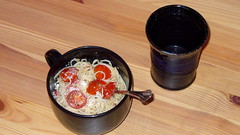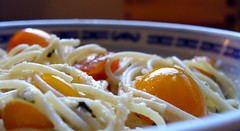Back in late June/early July, I found that I weighed 300 lbs. For the first time, I had to buy a pair of pants at a "big men" store: size 46 waist. I'm a big guy. I'm almost 6'3", and have broad shoulders. But this was ridiculous. I decided to do something.
For me, the difference between a diet and a lifestyle is that a diet is temporary, while a lifestyle is something you can continue forever. A diet is something you can't wait to be done with, while a lifestyle is your daily routine.
I learned two key lessons while finding a good lifestyle:
- You must want to be fit more than you want to binge or not sweat. A healthy lifestyle will involve some moderation in eating, and some exercise. So, if binging and not sweating are more important to you than being fit, you'll have a hard time even starting.
- You can't resent your lifestyle. This is crucial, even if it means a lifestyle that's somewhat less effective. Simply put, if you resent it, eventually you won't do it.
Since I quite love stuffing myself, and I hate exercise, one would think I'd resent any lifestyle that required differently. However, I found that if I keep such sacrifices reasonable, the resulting weight loss makes up for them. In other words, I don't resent moderate exercise so much when the pounds are coming off.
Now I'll describe the lifestyle I settled on after a few weeks of experimentation. I've maintained it with little effort for 7 months, during which I've gone from 300 lbs and size 46 pants to 215 lbs and size 36 (the pictures above show me then and now, wearing the same jeans). Most importantly, it's easy enough to maintain that I see no reason to ever stop. It comprises two aspects: eating right and exercising.
Eating Right
My goal is to keep my metabolism high, and avoid foods that quickly become fat. Thus, I follow these guidelines:
- Eat four to six small meals a day, every 3 to 4 hours (I try to leave feeling slightly hungry; I'll eat again soon enough)
- Eat more protein than carbohydrates.
- Drink lots of water (I drink multiple cups with each meal, and between meals).
- Avoid carbohydrates after lunch.
- Avoid fatty foods, such as dairy, certain cuts of meat, etc.
- No empty calories, such as desserts or non-diet soda.
Then, there's the two most important guidelines of all:
- Once a week, eat whatever and however much you want. Indian buffets, pizza, ice cream, pasta...anything. Partly, this actually helps you lose weight because it convinces your body there's no famine. But more importantly, it lets you address any cravings that build during the week. My free day is Saturday, and I look forward to it all week.
- If a rare opportunity for food comes along, it's okay to take it. Opportunities like parties, or travel (I feasted for a whole week while in Vienna). And don't feel bad, or give up your weekly binge for it. Sure, it's sub-optimal. But what's even less optimal is feeling so restricted you give up on your lifestyle entirely. Just make sure it happens rarely.
These last two are the most important guidelines because they keep away that fatal resentment.
Given these guidelines, my typical meals are as follows:
Breakfast: 9:00am
- 1/4 cup low fat cottage cheese, or
- 1 egg, fried in olive oil or hard-boiled
I prefer quick breakfasts, and I'm not hungry in the morning. Thus, a typical breakfast is 1/4 cup of low fat cottage cheese (0.75g saturated fat, 2.5g carbs, 6g protein), with some freshly ground black pepper for seasoning. Another option is an egg fried in olive oil, or hard-boiled.
Lunch: 12:30pm
- Moderate portion at restaurant, with vegetables and as much protein as carbs
Since it's still early in the day and my metabolism is going, I eat more for lunch than other meals, including more carbs. This makes lunch my most free meal. Anything with moderate portions, vegetables, and low-fat carbs and protein is good. The key is to eat as much protein as carbs, and to leave a bit hungry.

Typical lunch, from a Peruvian restaurant
There are several restaurants near my workplace that I frequent for lunch. I like almost any special at a nearby Chinese restaurant, though I eat only half the rice. There are Peruvian, Korean, and African restaurants with perfect meals (Madison is great for restaurants). There's also a sports bar with a good chicken salad, and a burger joint with lean bison and ostrich burgers. Again, the key is low fat, as much protein as carbs, and leaving a bit hungry. Given this, it's easy to find good lunches almost anywhere.
Snack: 4:00pm
- 3 or 4 pieces of beef jerky, or
- 1/3 of a high protein meal replacement bar

1/3 of a high-protein meal replacement bar for a snack
Three or four hours later, I have a snack. This is a very light meal, about 100 calories, and protein-heavy. One good snack is three or four pieces of beef jerky (0g saturated fat, 5g carbs, 11g protein). Since I get tired of jerky, I've started alternating with high-protein meal replacement bars from nutrition stores like GNC. I look for low fat and few net carbs, then eat about a third of a bar (1/3 of a Myoplex Carb Control bar is 90 calories, 1.5g saturated fat, 1.3g net carbs, 8.3g protein). The bars aren't as ideal as jerky, but they're nice variety and sweet, which helps to avoid resentment.
Dinner: 7:30pm
- 1 cup of mixed vegetables and protein
I eat dinner after getting home and exercising. Dinner isn't as light as my breakfast or snack, but it's much lighter than lunch. I typically have 1 cup of mixed vegetables and protein. For example, my last few dinners were tofu stir-fry. Other common dinners are seasoned ground beef with peas or broccoli, or leftovers from a Mexican restaurant (no carbs, so a meat dish in sauce, like pollo ranchero or steak in green chile sauce)

Light dinner: tofu stir fry
Since dinner is small, I typically cook a large portion, then have a little each evening. This applies equally well to take-out: a dinner portion at a Mexican restaurant serves for three or four dinners.
Dinner is usually my last meal. However, if I'm going to be up past midnight, I sometimes have another snack around 11:00pm.
Exercising
I detest exercising. I hate it beforehand, during, and afterwards. Thus, to keep resentment low, I minimize exercise time: 20-30 minutes per day, 5-6 days a week. I don't exercise on Saturday, my free day, and I only exercise on Sunday if I feel inspired. However, when I exercise, it's with high intensity.
I do both cardio and resistance training: on Mondays, Wednesdays, and Thursdays, I use a stationary bike or run; on Tuesdays and Thursdays, I lift weights. Since I hate exercising, if I have an excuse, I'll eventually take it. To combat this, I bought a stationary bicycle, a weight bench, and a dumbbell set. This minimizes time overhead, since I can exercise at home.
Below I describe my typical workouts. They're all short, but high-intensity.
Cardio: Stationary Bike
I use a stationary bicycle for cardio, largely because they're relatively inexpensive and fit easily in my apartment. However, my workout works well with any aerobic exercise with variable intensity. It is a variation on the Body for Life cardio workout.
The workout comprises four parts:
- Low intensity warm-up: 1 minute
- 3 sets of
- Mid intensity: 3 minutes
- High intensity: 3 minutes
- Very high intensity sprint: 1 minute
- Low intensity cool-down: 1 minute
This is a tougher workout than it sounds. I push so that I don't think I'll be able to finish the last set. Then, when I do, I push one more minute of all-out sprinting. I am definitely sweaty and exhausted by the end. However, since it only lasts 21 minutes, it's over quickly.
Resistance: Bench and Dumbbells
Muscle burns fat, so more muscle burns more fat. It also makes you stronger and look better. Thus, resistance training is just as important as cardio. It doesn't take much equipment, either: my whole workout uses only one pair of dumbbells with changeable weights, and a weight bench.
For each muscle group I exercise, I do three sets of six repetitions, with 30-60 seconds of rest between sets. Then, without rest after the third set, I do a fourth set of six reps, but of a different exercise for the same muscle. For instance, for pectorals, I might do a set of fly, rest, another fly set, rest, a third fly set, and immediately after a set of bench press. The key is to exhaust the muscle; if I can finish the fourth set a couple workouts in a row, then I increase the weight.
I concentrate on my upper body. I know this is sub-optimal, since it ignores the big muscles in my legs. However, I really don't like lower body exercises, and they were making me dread my workout. Thus, to minimize resentment, I left my lower body to the stationary bicycle.
I exercise four muscle groups: chest, biceps, triceps, and shoulders. For each group, I pick a primary and secondary exercise, then swap every few months. These are the exercises I like:
Results
So far, I've stuck to my new lifestyle for 7 months, without much effort. I've lost 85 pounds, and 10 inches off my waist. I've also gained noticeable muscle. I feel much healthier: I've got more energy, and can participate in many more activities. I've been told I even move much differently. Given all this, I'd say my new lifestyle is a success, and I plan to continue it indefinitely.















